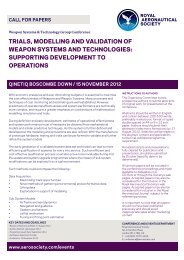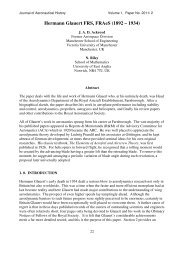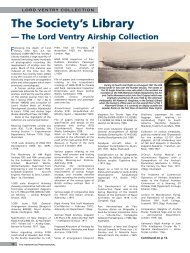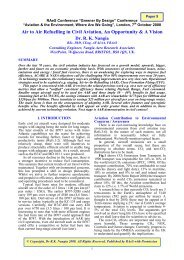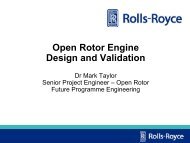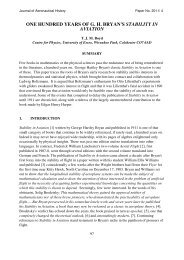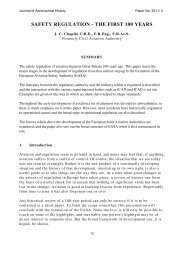Smoke, Fire and Fumes in Transport Aircraft - Royal Aeronautical ...
Smoke, Fire and Fumes in Transport Aircraft - Royal Aeronautical ...
Smoke, Fire and Fumes in Transport Aircraft - Royal Aeronautical ...
You also want an ePaper? Increase the reach of your titles
YUMPU automatically turns print PDFs into web optimized ePapers that Google loves.
58<br />
2.11 Review of system<br />
status<br />
2.12 Deferred items Are deferred items clearly identified? Actions, which will be carried out at a later phase of<br />
flight, should be at the end of the checklist <strong>and</strong><br />
should be clearly labelled. It is recommended that a<br />
label such as ‘deferred item’ precede the f<strong>in</strong>al<br />
deferred action items (see CAP 676 Appendix 3,<br />
Example 5).<br />
2.13 Crew responsible Where appropriate does the checklist <strong>in</strong>dicate who<br />
is responsible for carry<strong>in</strong>g out the drill?<br />
Layout <strong>and</strong> Format<br />
3.3 Cont<strong>in</strong>uation pages Is it clear when the drill cont<strong>in</strong>ues onto another<br />
page?<br />
3.4 Order Does the order of the action items ensure that the<br />
failure is fixed at the earliest opportunity?<br />
<strong>Smoke</strong>, <strong>Fire</strong> <strong>and</strong> <strong>Fumes</strong> <strong>in</strong> <strong>Transport</strong> <strong>Aircraft</strong><br />
Is a review of system status <strong>and</strong> operational<br />
capability provided on the checklist?<br />
Is there sufficient <strong>in</strong>formation to carry out the<br />
deferred step?<br />
3.1 Drills per page If the drill runs onto a second page is it split at a<br />
logical place <strong>in</strong> the drill?<br />
3.2 Start <strong>and</strong> f<strong>in</strong>ish Does the drill have a clearly def<strong>in</strong>ed start? The drill will be unusable if it is not clear where the<br />
drill starts. It must have a clearly def<strong>in</strong>ed start.<br />
Does the drill have a def<strong>in</strong>ed end? The end of drill must be <strong>in</strong>dicated with an ‘end of<br />
xxx drill’ <strong>in</strong>dication or graphical equivalent (see<br />
CAP 676 Appendix 3, Examples 2 <strong>and</strong> 4).<br />
Are the end of drill <strong>in</strong>dications provided <strong>in</strong> every<br />
place on the drill where it is complete, <strong>in</strong>clud<strong>in</strong>g<br />
decision steps?<br />
A system status review provides the crew with<br />
diagnostic <strong>in</strong>formation regard<strong>in</strong>g system capability.<br />
They are useful <strong>in</strong> deal<strong>in</strong>g with a failure situation,<br />
which cannot be rectified. It is recommended that<br />
consideration be given to <strong>in</strong>clud<strong>in</strong>g a table or list,<br />
detail<strong>in</strong>g system failures <strong>and</strong> alternate operational<br />
capability <strong>in</strong> the checklist (see CAP 676 Appendix<br />
3, Example 5).<br />
Are they grouped accord<strong>in</strong>gly? Deferred items are easier to use if they are clearly<br />
grouped accord<strong>in</strong>g to phase of flight or an<br />
environmental condition. It is recommended that<br />
group<strong>in</strong>g techniques are used.<br />
When return<strong>in</strong>g to a checklist to carry out items that<br />
have been deferred, it is necessary to recall the<br />
system deficiencies <strong>and</strong> carry out the actions<br />
correctly. To aid recall it is recommended that ‘do’<br />
actions be spelt out explicitly.<br />
The <strong>in</strong>structions should <strong>in</strong>dicate who is responsible<br />
for carry<strong>in</strong>g out the drill. If this changes for any of<br />
the drills it should be specifically stated as to who is<br />
responsible for specific actions.<br />
Drills should be split <strong>in</strong>to logical sections <strong>and</strong> the<br />
logical sections should not be split at a page break,<br />
as it impacts cont<strong>in</strong>uity of the drill.<br />
The end of drill must be <strong>in</strong>cluded at all places <strong>in</strong> the<br />
drill when it is complete (see CAP 676 Appendix 3,<br />
Example 2).<br />
The drill may not be completed if it is not clear that<br />
it cont<strong>in</strong>ues onto another page. It is recommended<br />
that a clear <strong>in</strong>dication be provided at the bottom of<br />
the page <strong>and</strong> top of the cont<strong>in</strong>u<strong>in</strong>g page (see CAP<br />
676 Appendix 3, Examples 4 <strong>and</strong> 5).<br />
The design of the drill must ensure that priority<br />
items, i.e. those that will deal with the fault <strong>in</strong> the<br />
most time- efficient way, are <strong>in</strong> the appropriate<br />
order.




